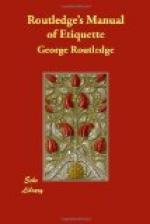Baskets filled with small bouquets are brought in. Each gentleman provides himself with a bouquet, and presents it to the lady with whom he wishes to valse.
Sometimes a light pole or staff is introduced, to the top of which are attached long streamers of different coloured ribbons. A lady takes one of these to several of her fair companions in turn, each of whom chooses a ribbon, and, holding it firmly in her hand, follows the leading lady to the room. Here they are met by an equal number of gentlemen, likewise grouped around a leader who carries the pole, while each holds a streamer of his favourite colour, or that which he imagines would be selected by the dame de ses pensees. The merry groups compare notes: those who possess streamers of the same colour pair off in couples, and valse gaily round the room, returning to places as before.
Six or eight ladies and the same number of gentlemen form in two lines, facing each other. The leading lady throws a soft worsted ball of bright colours at the gentleman with whom she wishes to dance. He catches it, throws it back to the fair group, and valses off with his partner. Whoever catches the returning ball, has the right to throw next; and the same ceremony is repeated until all have chosen their partners, with whom they valse round the room, returning to places as usual. Sometimes a handkerchief is substituted for the ball; but the latter is better, being more easily thrown and caught.
Six or eight chairs are placed in a circle, the backs turned inwards. Ladies seat themselves in the chairs, gentlemen move slowly round in front of them. Each lady throws her handkerchief or bouquet at the gentleman with whom she wishes to dance as he passes before her. Valse round as usual and return to places.
Sometimes a gentleman is blindfolded, and placed in a chair. Two ladies take a seat on either side of him; and he is bound to make his selection without seeing the face of his partner. Having done so, he pulls the covering from his eyes, and valses off with her. It is a curious circumstance that mistakes seldom occur, the gentleman being generally sufficiently clairvoyant to secure the partner he desires.
We have here described a few of the most striking figures of the Cotillon. We might multiply them to an extent which would equally tax the patience of our readers and our own powers of remembrance; but we forbear. Enough has been told to show the graceful, coquettish character of the dance, which adapts itself admirably to the Italian nature, and is as much beloved by them as the Valse by the Germans or the Cachucha by the dark-eyed maidens of Spain. We should rejoice to see this charming stranger naturalised in English ball-rooms. It is especially adapted to sociable gatherings, where most of the guests are friends or acquaintances.
* * * * *
XXII.—THE SPANISH DANCE.




